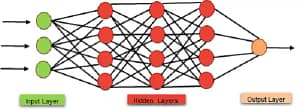In today’s fast-paced digital era, the world of technology is constantly evolving, with groundbreaking innovations emerging at an unprecedented rate. Among these transformative technologies, deep learning and neural networks stand out as true game-changers. In this comprehensive article, we will dive deep into the realm of deep learning and neural networks, exploring what they are, how they work, their applications, and the promising future they hold.
Understanding Deep Learning
In the recent past, deep learning, a branch of machine learning, has attracted significant interest because of its ability to emulate the learning processes of the human brain. At its core, deep learning relies on intricately designed artificial neural networks, purpose-built to meticulously process and analyze vast datasets with precision, thereby granting machines the capability to make insightful decisions and predictions.
The Neural Network Architecture
The foundation of deep learning lies in its neural network architecture. Just like the human brain consists of interconnected neurons, artificial neural networks are composed of layers of nodes, known as neurons, that process and transmit information. These layers are categorized into three types:
- Input Layer: This is where the network receives data from external sources. Each neuron in the input layer represents a feature or variable.
- Hidden Layers: These layers in between process input data through a sequence of mathematical operations. Deep learning models often incorporate several intermediate layers, facilitating intricate data transformations.
- Output Layer: The final layer provides the model’s output, which can vary depending on the task, such as classification, regression, or generation.

Types of Neural Networks
Neural networks manifest in a variety of forms, each meticulously tailored for specific tasks and applications. Let’s explore some of the primary types of neural networks:
- Feedforward Neural Network (FNN): The FNN stands as the most straightforward neural network variant, orchestrating information flow in a singular direction, devoid of loops or cycles. It is conventionally harnessed for tasks such as classification and regression.
- Convolutional Neural Network (CNN): Designed with a focus on handling grid-like data, like images and videos, CNNs harness convolutional layers to autonomously discern and abstract features from the input data. They excel notably in domains like image recognition and computer vision.
- Recurrent Neural Network (RNN): Tailored for sequential data scenarios, where the sequence and order of inputs hold significance, RNNs incorporate loops that facilitate the persistence and transfer of information from one step in the sequence to the next. Consequently, they find utility in applications such as natural language processing (NLP) and time series analysis.
The Power of Neural Networks
Deep Learning vs. Traditional Machine Learning
The distinguishing factor that separates deep learning from traditional machine learning algorithms is its innate capability to autonomously derive features from raw data. In conventional machine learning, the process of feature engineering assumes paramount importance, involving the utilization of domain expertise to handpick and construct pertinent features. In sharp contrast, deep learning possesses the ability to autonomously acquire and distill features, rendering it highly versatile across a spectrum of tasks.
Training Deep Neural Networks
The training of a deep neural network encompasses a procedure referred to as backpropagation. During this process, the model refines its internal parameters iteratively to diminish the disparity between its predictions and the true target values. This iterative refinement persists until the model attains a commendable level of accuracy.
Applications of Deep Learning and Neural Networks
The adaptability of deep learning and neural networks has prompted their extensive embrace across diverse sectors. Here are some compelling instances of their applications:
1. Computer Vision
Deep learning has sparked a revolution in computer vision, empowering machines to identify objects, faces, and even emotions within images and videos. This has paved the way for advancements in autonomous vehicles, surveillance systems, and medical image analysis.
2. Natural Language Processing (NLP)
In the realm of NLP, neural networks have greatly improved language understanding and generation. Chatbots, language translation services, and sentiment analysis tools are just a few examples of NLP applications powered by deep learning.
3. Healthcare
Deep learning models have demonstrated remarkable accuracy in diagnosing diseases from medical images and predicting patient outcomes. They are also used in drug discovery and genomics research, accelerating advancements in healthcare.
4. Finance
Financial institutions employ neural networks for fraud detection, algorithmic trading, and credit risk assessment. These models analyze vast datasets to make real-time decisions, enhancing security and profitability.
5. Autonomous Systems
In the field of robotics, deep learning plays a pivotal role in enabling autonomous systems to perceive and interact with their environment. Self-driving cars and drones rely on neural networks for navigation and decision-making.
The Future of Deep Learning and Neural Networks
As we peer into the future, the path of deep learning and neural networks unfolds with abundant promise. Here, we explore some examples:
1. Explainable AI (XAI)
Researchers are working on making deep learning models more interpretable and transparent. This will enhance trust in AI systems and allow us to understand the reasoning behind their decisions.
2. Edge AI
The deployment of AI models on edge devices, such as smartphones and IoT devices, will enable faster processing and reduce reliance on cloud-based computing. This has implications for real-time applications like autonomous vehicles and augmented reality.
3. AI in Scientific Discovery
Deep learning is positioned to expedite scientific advancements through its capacity to scrutinize intricate datasets, forecast chemical reactions, and contribute to the process of discovering new drugs. This holds the promise of fundamentally transforming disciplines such as materials science and environmental research.
Application Example
Image Classification with CNNs
Problem: Suppose you want to build a system that can automatically identify objects or animals in images, such as distinguishing between cats and dogs.
Solution: You can employ a Convolutional Neural Network (CNN) for this task. Here’s how it works:
- Data Collection: Collect a large dataset of labeled images, with each image containing either a cat or a dog. This dataset is used for both training and testing the CNN.
- Network Architecture: Design a CNN architecture that typically consists of multiple convolutional layers, pooling layers, fully connected layers, and an output layer. CNNs are specifically designed to process images efficiently.
- Training: Train the CNN using the labeled dataset. During training, the network learns to extract relevant features from the images, such as edges, textures, and shapes, that are indicative of whether the image contains a cat or a dog. The network adjusts its parameters (weights and biases) through backpropagation and optimization algorithms (e.g., gradient descent) to minimize the classification error.
- Testing: After training, use a separate set of images that the network has never seen before to evaluate its performance. The CNN will make predictions (cat or dog) for each image, and you can compare these predictions to the ground truth labels to measure its accuracy.
- Deployment: Once the CNN has been trained and tested satisfactorily, you can deploy it in real-world applications. For example, you could use it to automatically classify images uploaded by users on a social media platform or to automate the sorting of images in a photo library.
Conclusion
To sum up, deep learning and neural networks stand at the vanguard of technological progress, exerting a profound influence on industries and reshaping our lifestyles and workplaces. Their capacity to glean insights from data, adapt to fresh challenges, and propel advancements across diverse domains underscores their paramount importance. As we persist in exploring the boundless prospects offered by deep learning, one certainty emerges: the future gleams with promise, offering limitless potential for positive transformation. Embracing this technology isn’t merely a choice; it’s an imperative on our journey toward a smarter, more efficient world.



